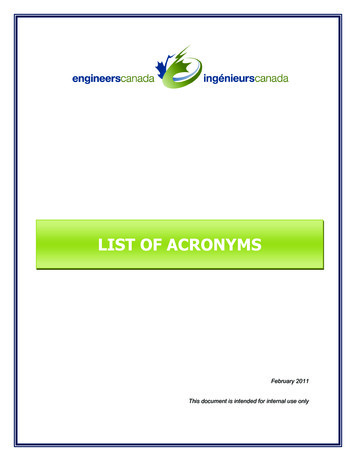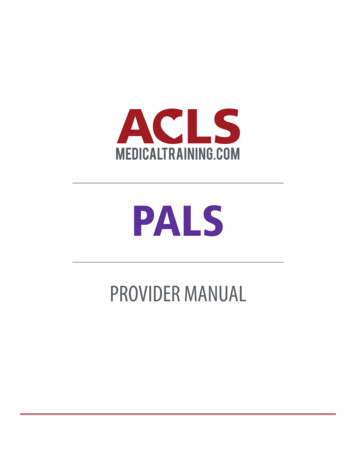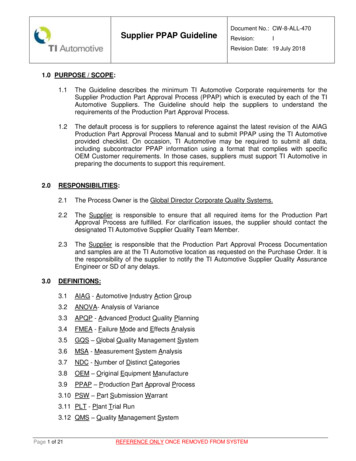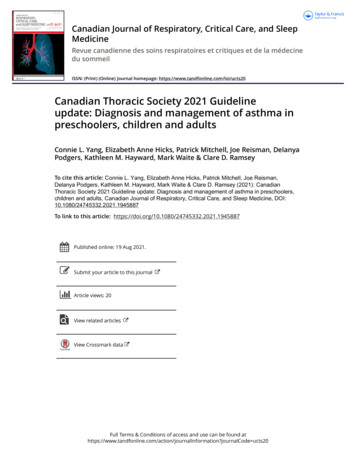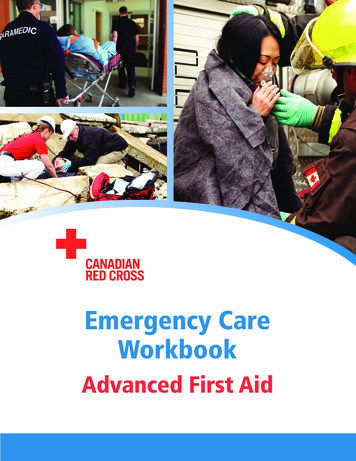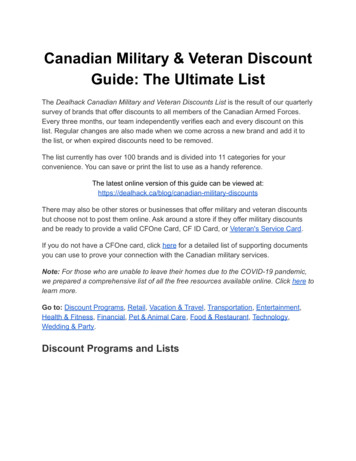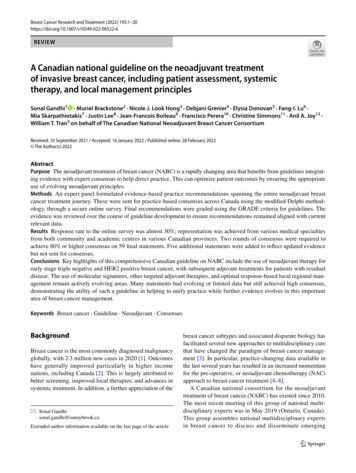
Transcription
Breast Cancer Research and Treatment (2022) -6REVIEWA Canadian national guideline on the neoadjuvant treatmentof invasive breast cancer, including patient assessment, systemictherapy, and local management principlesSonal Gandhi1 · Muriel Brackstone2 · Nicole J. Look Hong3 · Debjani Grenier4 · Elysia Donovan5 · Fang‑I. Lu6 ·Mia Skarpathiotakis7 · Justin Lee8 · Jean‑Francois Boileau9 · Francisco Perera10 · Christine Simmons11 · Anil A. Joy12 ·William T. Tran5 on behalf of The Canadian National Neoadjuvant Breast Cancer ConsortiumReceived: 10 September 2021 / Accepted: 16 January 2022 / Published online: 28 February 2022 The Author(s) 2022AbstractPurpose The neoadjuvant treatment of breast cancer (NABC) is a rapidly changing area that benefits from guidelines integrating evidence with expert consensus to help direct practice. This can optimize patient outcomes by ensuring the appropriateuse of evolving neoadjuvant principles.Methods An expert panel formulated evidence-based practice recommendations spanning the entire neoadjuvant breastcancer treatment journey. These were sent for practice-based consensus across Canada using the modified Delphi methodology, through a secure online survey. Final recommendations were graded using the GRADE criteria for guidelines. Theevidence was reviewed over the course of guideline development to ensure recommendations remained aligned with currentrelevant data.Results Response rate to the online survey was almost 30%; representation was achieved from various medical specialtiesfrom both community and academic centres in various Canadian provinces. Two rounds of consensus were required toachieve 80% or higher consensus on 59 final statements. Five additional statements were added to reflect updated evidencebut not sent for consensus.Conclusions Key highlights of this comprehensive Canadian guideline on NABC include the use of neoadjuvant therapy forearly stage triple negative and HER2 positive breast cancer, with subsequent adjuvant treatments for patients with residualdisease. The use of molecular signatures, other targeted adjuvant therapies, and optimal response-based local regional management remain actively evolving areas. Many statements had evolving or limited data but still achieved high consensus,demonstrating the utility of such a guideline in helping to unify practice while further evidence evolves in this importantarea of breast cancer management.Keywords Breast cancer · Guideline · Neoadjuvant · ConsensusBackgroundBreast cancer is the most commonly diagnosed malignancyglobally, with 2.3 million new cases in 2020 [1]. Outcomeshave generally improved particularly in higher incomenations, including Canada [2]. This is largely attributed tobetter screening, improved local therapies, and advances insystemic treatment. In addition, a further appreciation of the* Sonal Gandhisonal.gandhi@sunnybrook.caExtended author information available on the last page of the articlebreast cancer subtypes and associated disparate biology hasfacilitated several new approaches to multidisciplinary carethat have changed the paradigm of breast cancer management [3]. In particular, practice-changing data available inthe last several years has resulted in an increased momentumfor the pre-operative, or neoadjuvant chemotherapy (NAC)approach to breast cancer treatment [4–8].A Canadian national consortium for the neoadjuvanttreatment of breast cancer (NABC) has existed since 2010.The most recent meeting of this group of national multidisciplinary experts was in May 2019 (Ontario, Canada).This group assembles national multidisciplinary expertsin breast cancer to discuss and disseminate emerging13Vol.:(0123456789)
2evidence-based guidance across the country, and in particular focus on areas that have incomplete evidence andrequire expert opinion to help direct practice. Variousmembers of this group have previously published meetingreports and one expert consensus guideline, with a significant focus on the utility of NAC for locally advancedbreast cancer (LABC) [4–6]. However, over the last fewyears, research has increasingly demonstrated the important prognostic and predictive implications of treatingcertain subtypes of early breast cancer (HER2 positiveand triple negative) with NAC [3], irrespective of upfrontclinical stage or operability. The routine use of NAC forearly stage breast cancer that is operable on presentationis a paradigm shift of great importance, with significanttherapeutic and resource implications [7, 8]. Rapidlyevolving evidence, the paucity of long-term data in somestudies, the use of variable patient endpoints, and drugfunding disparities within the country, can create someuncertainty in therapeutic approaches, but also opportunities for ongoing clinical trials [9]. Considering all this,there is an ongoing need for expert opinion to help consolidate the approach to NABC patient management. Thisis paramount to achieving the best possible uniform outcomes for Canadian breast cancer patients, particularlyconsidering the publicly funded healthcare landscape.International breast oncology guidelines often embed theuse of NAC within larger documents pertaining to breastcancer management [10]. In addition, some of the NACrecommendations are resource and practice-setting specific; there also remains some debate around the impact ofcertain research findings on clinical care (example usingpathologic complete response rate as a practice-changingendpoint). Finally, most guidelines, including the recentlypublished American Society of Clinical Oncology (ASCO)document, focus on systemic therapy alone [11], and donot include the subsequent implications of systemic therapy on surgical and radiation therapy decision-making.We, therefore, developed a contemporary, evidence-basedCanadian National Consensus on the Neoadjuvant Treatment of Breast Cancer, using validated consensus methodology. This is meant to capture the most up-to-dateevidence on optimal patient management throughout theentire treatment journey, while aligning multidisciplinaryexpert opinion with practice-based consensus from clinicians across the country.Guideline type: Evidence Based Consensus.Intended users: Practitioners who treat invasive breastcancer (pathology, radiology, surgery, medical oncology,radiation oncology, and other involved health professions.)Applicable resource setting: Upper middle to highincome nations with access to advanced screening, diagnostic, pathologic, surgical, radiation, and systemic therapyoptions.13Breast Cancer Research and Treatment (2022) 193:1–20MethodsExpert guideline panelAn expert guideline steering committee was establishedat the most recent Canadian National NABC Consortiummeeting (May 2019, Ontario, Canada). The committeewas comprised of academic and clinical experts in breastcancer management in the following specialties: medicaloncology, surgical oncology, radiation oncology, breastradiology and anatomic pathology. All committee expertspractice in academic cancer centres for more than 5 years,treat more than 100 unique breast cancer patients per year,and have demonstrated research and academic impact inNABC (peer-reviewed publications, research grants/projects, clinical trials involvement, and/or academic meeting presentations.) Representation from multiple Canadianprovinces was sought.Systematic evidence reviewA systematic review of the literature was performed. Asmanagement for the neoadjuvant treatment of locallyadvanced breast cancer and general treatment principlesof early breast cancer are well-established [5, 10, 11], thefocus of the review was to update established principlesof NABC care and highlight areas of new or evolving evidence that in particular would benefit from consensus tohelp improve practice. The overall focus was defined as thecomprehensive management of breast cancer with a neoadjuvant therapy approach, including specific attention to thedomains of multi-disciplinary assessment, diagnosis, monitoring, systemic therapy and local treatment. To maintainscope and feasibility, a single database search (PUBMED)was performed with the following parameters: invasivebreast cancer, neoadjuvant, limited to phase 3 or 4 studies,meta-analysis, systematic review, or guidelines publishedin the English language. To focus mainly on new developments in this area, the search was limited to the past5 years (initially October 2015 to October 2020 inclusive);the search was then repeated for November 2020 to May2021 prior to manuscript preparation, to ensure no newrelevant evidence had been published (Fig. 1). In December 2020, July 2021, October 2021, and December 2021,a targeted online gray literature search was completed toreview any updated evidence as presented at four highimpact oncology meetings (San Antonio Breast CancerSymposium 2020 and 2021, American Society of ClinicalOncology 2021, European Society of Medical Oncology2021), and any new published guidelines. The guidelinepanel decided it was important to capture any relevant
Breast Cancer Research and Treatment (2022) 193:1–203Fig. 1 Literature search consort diagram. There were 78 studies included for analysis after applying the inclusion and exclusion criterianew evidence with a select few additional recommendations, to ensure the guideline was most up-to-date. It wasdecided a priori that if the new evidence did not changethe relevance or accuracy of existing recommendations, orgreatly change the guideline’s scope or impact, these fewselect recommendations would not be sent for consensusto prevent delays in final guideline submission.Consensus statements and consensus processThe steering committee developed recommendations forconsensus based on the evidence review and discussion ofimportant principles of NABC care, as established duringand since the last Canadian NABC consensus statementin 2015 [5]. Discussions were held virtually (telephone),and via email correspondence. The statements were furtherreviewed by five additional clinical experts in breast surgical, radiation, and medical oncology; these expert reviewers were identified from past Canadian NABC Consortiuminvolvement. Representation from multiple provinces wasagain ensured.The Modified-Delphi approach is well recognized as arobust consensus methodology, particularly for consensus development in healthcare [12, 13]. This anonymous,survey-based consensus guideline model has several advantages compared to more traditional expert-based or nominalgroup methods; the latter rely solely on the opinions of aselect group of individuals, and can be more subject to bias13
4or the influence of the most vocal members of a guidelinecommittee. Using the modified-Delphi approach, final statements were emailed to potential physician respondents usinga secure online survey platform (Survey Monkey Inc., SanMateo, California, USA). Potential respondents were identified as being probable breast cancer clinicians by nationalor provincial medical society membership, provincial cancercentre affiliation, description of medical practice as availablein public domain (example: institutional websites), recommendation by invited colleagues, and/or previous attendance at Canadian National NABC Consortium meetings.Invited participants were instructed only to respond if theyhad enough clinical expertise and experience in the neoadjuvant treatment of breast cancer to have an opinion. Toachieve a broad practice-based consensus on expert recommendations, the guideline committee preferred not to restrictresponses by years of practice or number of patients, andassumed respondents would only engage in the survey ifthey felt comfortable with the subject matter. Invitation toparticipate in the consensus process was carried out usingemail addresses for these individuals, as available in the public domain or through personal solicitation from the steering committee, or as shared by invited colleagues. Giventhe focus of this guideline was an practice-based physicianconsensus, other health care disciplines, and patient representatives were not included in the statement development orconsensus process itself. Widespread physician representation was targeted, including multidisciplinary providers inboth academic and community centers and in all Canadianprovinces with comprehensive cancer programs.Responses were anonymous; only respondent demographics including discipline, geographic area of practice, andyears in practice were collected. Respondents were askedto indicate agreement, disagreement, or neutrality (i.e., "noopinion") to each statement. Given that multiple oncologyspecialties were involved, respondents were asked to indicate "no opinion" only if the statement was outside of theirarea of direct practice and not because they had no opinion about a statement related to their specialty. Reminderswere sent twice over an 8-week period. Respondents wererequired to provide detailed qualitative feedback regardingstatements they disagreed with. Specifically, respondentswere instructed that if they did not agree with a statement inits entirety, to indicate disagreement, and provide detailedfeedback regarding the elements they did not agree with.As per Modified-Delphi process, statements that did notachieve consensus were reviewed by the steering committeeand modified based on the qualitative feedback as collectedby the survey. These statements were emailed for a secondround of survey; this was emailed to the same participants.Participants were instructed to respond only if they hadresponded to the first survey; one reminder was sent over6 weeks. A third round was planned if required (Fig. 2).13Breast Cancer Research and Treatment (2022) 193:1–20Consensus analysisAgreement statistics were calculated for each statementbased on the total number of responses. The denominatorfor each statement (N, Agree Disagree) was calculated asthe sum of respondents who agreed and disagreed. Blankresponses and those who indicated "no opinion" wereexcluded from the total number of responses for each question. The numerator (n, Agree) corresponded to the numberof respondents who indicated "agree" for each statement.The proportion (n/N) was converted to a percent value (%)to determine the consensus value. A threshold value wasdetermined a priori; consensus was defined as statementswith 80% or more of respondents in agreement; statementswith consensus 79.5% were rounded up to 80%. Statementswith less than an 80% (i.e., 79.5%) agreement level weremarked for modification in the next round of survey, as perModified Delphi methodology. Qualitative feedback wascollected from respondents who indicated disagreement withparticular statements; this feedback was utilized to modifystatements that did not achieve consensus with the initialround.Grading of recommendationsThe final statements were ranked using the GRADE recommendations for guidelines (Strong or Conditional) [14], withconsideration of the four domains within the framework fora recommendation’s direction and strength, which include:estimates of effect for desirable and undesirable outcomesof interest, confidence in the estimates of effect, estimatesof values and preferences, and resource use [15]. In considering this framework, recommendations were generallyconsidered strong if they were based on positive data andhad level 1 or 2 evidence as per the GRADE frameworkfor ranking evidence [14], and met the threshold for consensus. If a recommendation was lacking updated level 1–2evidence in the last 5 years (acknowledging the review waslimited to this timeframe), was deemed imperative to patientcare and received a very high level of consensus ( 89%),it was also rated as strong. Recommendations deemed lessimpactful to patient care, with level 3 or 4 evidence, withpreliminary (short term) level 1 or 2 evidence, high resourceimplications/lack of public funding, or with no publishedevidence and consensus 90%, were marked as conditional.The term conditional was preferred over “weak” to indicatethese statements may have evolving data thatmay strengthenthe recommendation over time) and/or the statement maystill be impactful for patient care, particularly in certain contexts. Available evidence was linked to recommendations inthe “Grading” column (Tables 1 and 2). As the consensusstatements may have been based on several sources of evidence with varying strengths, and to illustrate the grading
Breast Cancer Research and Treatment (2022) 193:1–205Fig. 2 Modified-Delphi Process. Consensus statements were developed by the steering committee based on evidence and relevant discussion. Statements were reviewed by 5 additional experts, finalized,and emailed as a secure online survey. Two rounds were required forconsensus of 79% for all statementsof recommendations was not based on the strength of evidence alone (as discussed above), formal grading of the evidence was not integrated into the guideline table. Finally,additional statements added by the panel (Table 3) were allgraded as “conditional” to reflect that they were not sent forconsensus.ResultsEngagement of further stakeholdersThe final guideline was reviewed by a pharmacist, breastcancer patient representative, and a neoadjuvant nurse navigator, all affiliated with the Sunnybrook Health SciencesCentre. Their feedback on the premise of the guideline,agreement with recommendations, and on implementationwas sought.A total of 47 recommendations were initially created by thesteering committee and integrated into a consensus survey.Email invitations to complete the survey were sent to 391clinicians in October 2020. There were 109 participants whocompleted the survey, for a response rate of 28%. Surgicaloncology represented the largest respondent group (41/109;37.6%), followed by medical oncology (29/109; 26.61%)and radiation oncology (21/109; 19.27%) (Fig. 3). Respondents were predominantly within their mid-career level ofpractice. Geographical representation was achieved fromacross several Canadian provinces, although the majority ofrespondents were located in central Canada (66.0% Ontarioand Quebec), and at academic health institutions (77.0%).A summary of all respondent profiles is presented in Fig. 3.13
6Breast Cancer Research and Treatment (2022) 193:1–20Table 1 Round one consensusNoRecommendationA. General approachA.1 Multidisciplinary assessment, including consultation with the following, (1) Medical oncologist, (2) Surgeon/surgical oncologist and where applicable, plastic surgeon (3) Radiationoncologist. A multidisciplinary tumor board/cancer conference discussion (or access tothis forum if required.) Clinical trials/research protocol team, where applicable. Enrollment in clinical trials is encouraged. Nursing and other allied health support as requiredB. Neoadjuvant therapy patient selectionB.1 Neoadjuvant chemotherapy (NAC) is the standard of care for all locally advanced breastcancers (LABC), defined as T3/T4 tumors and/or N2-3, and all inflammatory breast cancers, regardless of biomarkersB.2 There is a suggestion that lobular carcinomas may not respond well to NAC; however, in theabsence of level 1 evidence suggesting otherwise (and the potential for mixed histologytumors), LABCs that are lobular will still often be treated with NACB.3 T1-2 tumors with upfront N1 disease that are ER-positive, HER-2 negative and deemedoperable, can be considered for upfront surgery in many cases. However, patients maystill be offered NAC, particularly to downstage to breast conservation and/or to allow forsentinel-lymph node biopsyB.4 NAC is the standard of care for all triple negative and HER-2 positive breast cancer patients,that have T2N0 or TxN1 disease, and are chemotherapy candidates. Tumors should ideallybe evaluable for clinical response monitoring (i.e., palpable)B.5 NAC for triple-negative or HER2-positive tumors that are T1N0 can be considered on acase-by-case basisSpecific tumor characteristics (for instance higher grade or T1c lesions) may help betterselect patients; the main consideration is likely the choice of chemotherapy regimen thatmay be offered either pre- or post-operatively (for instance, anthracycline sparing for aT1a/b lesion). Please refer to NAC treatment section belowB.6 NAC can be offered to any patient for tumor down-staging in order to facilitate breastconservation (this may be determined by tumor-to-breast size ratio, and not necessarilyupfront staging)C. Pre-treatment assessmentC.1 All patients being considered for neoadjuvant chemotherapy should have pre-treatmentbreast and axillary imaging, including:Bilateral mammogram: further targeted imaging (i.e., additional mammographic viewsand ultrasound) of breast and lymph nodes should be performed based on initial findings.Breast magnetic resonance imaging (MRI) can be considered for all patients planned forneoadjuvant therapy (provided MRI-guided biopsy resources are available), especially forlobular carcinomas. Patients should ideally have access to a rapid-diagnostic unit (RDU)or expedited diagnostic examinations, particularly for urgent clinical presentations (example: rapidly growing breast mass, inflammatory breast changes, etc.)C.2 Biopsy and clips: Core biopsy should be performed of suspicious breast lesions using themost appropriate technique and modality. Fine needle aspiration for suspicious lymphnodes is generally adequate, although core biopsy is appropriate also. For invasive breasttumors that are eligible for breast conserving surgery, a marker clip should be placed to beused for pre-operative localization in the event of complete clinical and radiologic treatment response. Where a sentinel lymph biopsy after neoadjuvant therapy is being considered, a clip should also be placed in a biopsy-confirmed positive lymph node, if applicableC.3 Staging: Cancer staging by imaging should be performed for all locally advanced breastcancers (T3/4 and/or any positive lymph nodes). This should include computed tomography (CT) of the chest, abdomen and pelvis, and a nuclear bone scan. Positron emissiontomography (PET) imaging could also be considered as per local guidelines or researchprotocols. Patients of any initial clinical stage who have symptoms suggestive of metastatic disease should also receive targeted imaging (symptom directed)C.4 Pathologic review by an experienced pathologist should be completed on all breast biopsyspecimens to confirm an invasive cancer. The pathologist should also report: Histologicaltype (WHO classification), if possible, Nottingham grade, if possibleC.5 Biomarkers should be reported on all core biopsies of invasive cancer, including: Estrogenreceptor (ER), Progesterone receptor (PR), Human epidermal growth factor-2 (HER2)receptor status (by IHC and ISH when indicated)13n/N% Consensus Grade [references]105/107 /9685.42Conditional78/9383.87Strong [22, 23]73/8684.88Conditional72/9476.60Conditional [24]81/9585.26Strong ng94/9796.91Strong
Breast Cancer Research and Treatment (2022) 193:1–207Table 1 (continued)NoC.6RecommendationSampled lymph nodes should be reported, at minimum, as benign or containing malignant/metastatic cells (designation of breast as primary site is helpful, if possible)C.7 Lymph nodes with carcinoma cells but no confirmed invasive disease in the breast should bere-sampled with a core biopsy to assess the histology and biomarkers, if applicable. Comprehensive breast imaging, including breast MRI, should be completed in these situationsto look for an occult breast carcinomaC.8 Multi-disciplinary assessment is important for most patients prior to initiation of NAC.Patients should be reviewed by both a medical oncologist and a surgeon prior to finalization of the initial NAC treatment plan. An early radiation oncology assessment shouldalso occur in those patients who may require salvage radiation therapy (example: locallyadvanced breast cancer and/or inflammatory breast cancer)Multidisciplinary case conference (MCC) assessment should be considered for any patientdeemed appropriate by treating physiciansC.9 Patients in whom breast reconstruction may be considered, consultation with a plastic surgeon and radiation oncologist early in treatment planning or initiation is idealC.10 A clinical care pathway disseminated to the entire care team can help standardize patientselection and management. In addition, a patient navigator (if resources are available),is often useful to coordinate initial investigations, multi-disciplinary communication,and subsequent patient follow up during key treatment milestones (example: completingchemotherapy, planning for surgery)C.11 Assessment for fertility preservation (if applicable) should be done prior to the start of neoadjuvant chemotherapy, if applicable and reasonable based on clinical presentationC.12 Genetics referral, counseling, and testing (if applicable) should be initiated early to permitinclusion of results into surgical planning*Added Note: Germline mutation testing for appropriate patients may also help selectpatients for certain adjuvant therapies; please see recommendation G.6 regarding the useof parp inhibitors in BRCA mutation carriersD. Neoadjuvant systemic therapyD.1 Chemotherapy is the standard of care for most invasive breast cancers being treated withpre-operative systemic therapy (neoadjuvant chemotherapy, NAC.) A third-generationchemotherapy regimen including anthracyclines and taxanes should be considered for 6–8cycles total, in most patientsD.2 Regarding specific NAC approaches: The sequence of agents (anthracycline or taxanes first)can be determined based on patient and disease characteristics, in order to optimize pCR.In general, anthracyclines are often given first. Anthracycline-sparing regimens shouldgenerally be reserved for patients at high risk for anthracycline toxicities. Shorter chemotherapy regimens, including taxane-based (such as TC or weekly-paclitaxel with trastuzumab for HER-2 positive) can be considered on a case-by-case basis, considering initialtumor staging (less than 2 cm, N0 disease) and grade (grade 1–2), patient preference, andtoxicity considerations. The implications for potentially requiring further treatment postoperatively for residual disease should also be considered, if the initial regimen is not astandard anthracycline-taxane regimen (refer to section on additional adjuvant therapies)Dose-dense (biweekly) regimens are preferred for patients who can tolerate them, particularly for ER-negative cancers, due to the potential for modest improvement in outcomescompared to non-dose dense regimensD.3 Regarding targeted therapies during NAC:The addition of a platinum to the taxane-containing portion of NAC can be considered fortumors with known BRCA-mutations, or for triple negative breast cancers; this is associated with an increase rate of pCR. The addition of platinums should also be consideredif suboptimal or progressive disease is observed in these tumors on the anthracycline portion of NAC. Trastuzumab should be given during the taxane portion of NAC for HER-2positive breast cancers. Pertuzumab (where accessible) should be considered in addition totrastuzumab, during the taxane portion of NAC for HER-2 positive breast cancers, particularly if there is node positive disease/locally advanced disease upfront. This is to improvethe chance of pathologic complete response (pCR rate). NAC with immunotherapy (PD-1or PDL-1 inhibitors) is considered investigational at this time, and most likely to benefittriple negative breast cancers. Clinical trials can be considered for such patients, if availablen/N% Consensus Grade .0Strong92/9596.84Strong50/5689.29Strong onal [28,34–51]13
8Breast Cancer Research and Treatment (2022) 193:1–20Table 1 (continued)NoRecommendationD.4Salvage* therapies for patients that progress on neoadjuvant chemotherapy include immediate surgery, if feasible. Switching to a non-cross resistant chemotherapy, especiallyplatinum based as above for triple-negative cancers or those with known BRCA mutations.This should be followed by surgery, if possible. Radiation, followed by surgery, if possible*Added Note: The term “salvage” refers to a change in treatment meant to address tumourprogression on initial therapyD.5 For patients receiving salvage* radiation (due to progression on NAC, see above), addingweekly cisplatin should be considered as a radiation-sensitizing agent, if the tumor istriple negative, and/or has a known BRCA mutation*Added Note: The term “salvage” refers to a change in treatment meant to address tumourprogression on initial therapyD.6 Neoadjuvant endocrine therapy is NOT considered standard of care at this time. However, it can be considered for ER-positive, HER-2 negative breast cancer patients witha preference to avoid chemotherapy (due to patient age, co-morbidities or functionalstatus). Chemotherapy candidates that may benefit from neoadjuvant endocrine therapyinstead of neoadjuvant chemotherapy have high ER/PR expression and low Ki-67 scoreat baseline, and/or at the 4- and 12-week mark of therapy, and/or low genomic profilingscores. Research protocols, where appropriate, assessing serial tumor response (such asKi-67 score) could be considered for these patients. The use of genomic profiling scoresto select candidates for neoadjuvant endocrine therapy versus chemotherapy remainsinvestigational at this time. The addition of CDK4/6 inhibitors to neoadjuvant endocrinetherapy remains investigational at this time; early evidence suggests it does not improveendocrine-responsiveness or pathologic response rates. The efficacy of neoadjuvantendocrine therapy for down staging most patients w
A Canadian national consortium for the neoadjuvant treatment of breast cancer (NABC) has existed since 2010. The most recent meeting of this group of national multi-disciplinary experts was in May 2019 (Ontario, Canada). This group assembles national multidisciplinary experts in breast cancer to discuss and disseminate emerging * Sonal Gandhi


